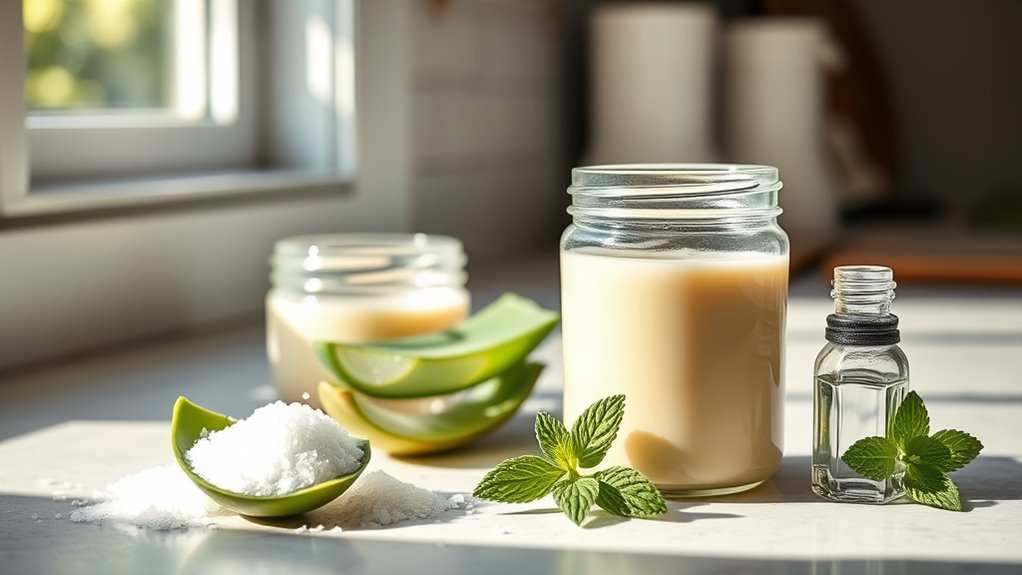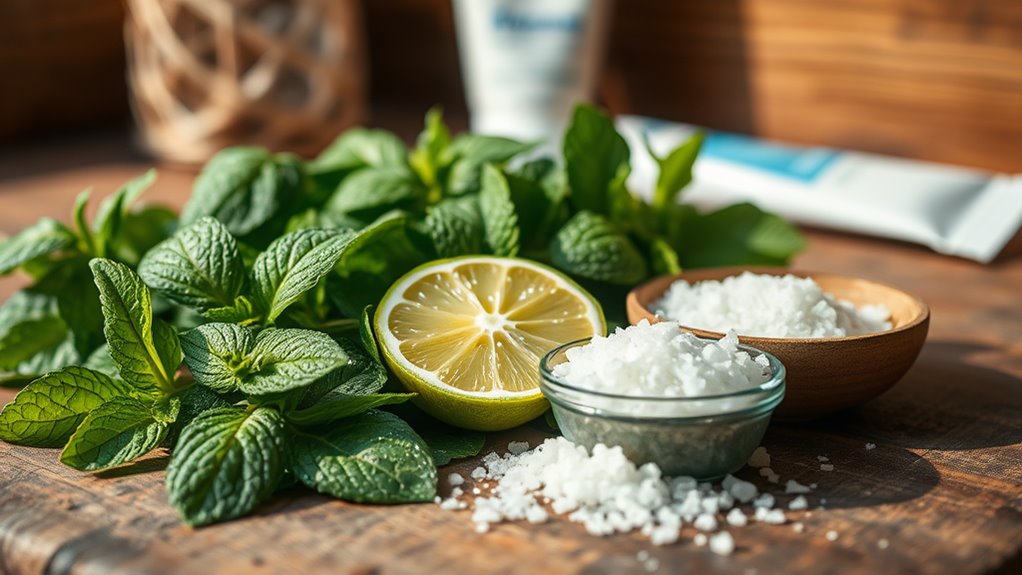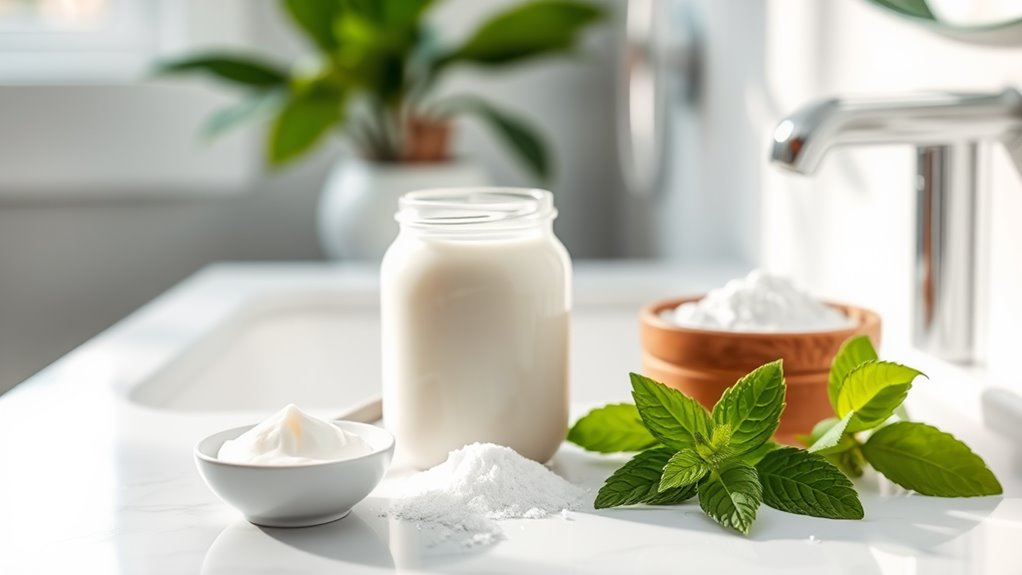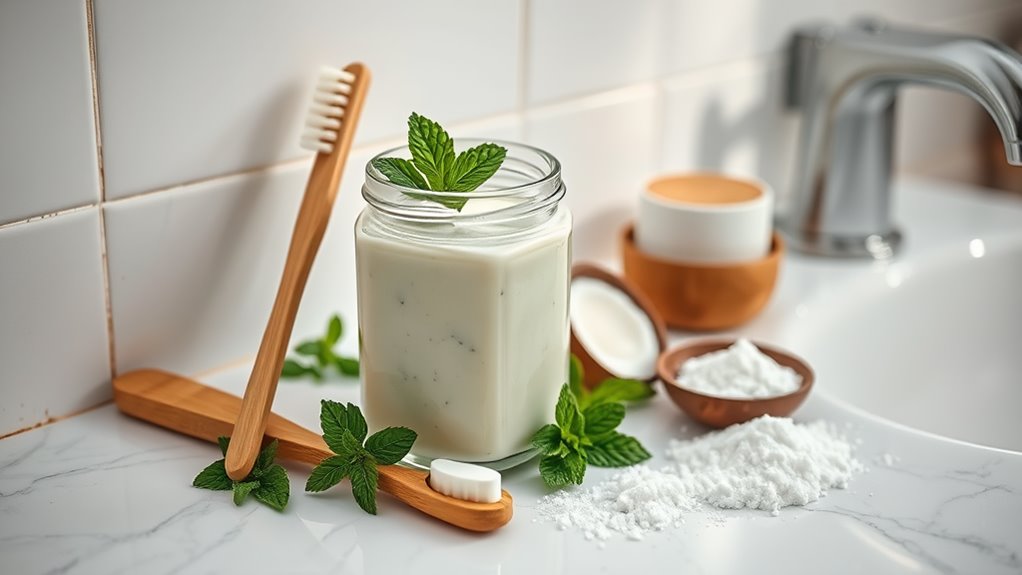The Ultimate DIY Toothpaste for Sensitive Teeth Revealed!
If you’re struggling with sensitive teeth, making a DIY toothpaste can help. Combine 2 tablespoons of baking soda with 1 tablespoon of coconut oil, then add 10-15 drops of peppermint essential oil for flavor. This natural mixture gently cleans and moisturizes while fighting cavity-causing bacteria. It’s cost-effective and customizes your flavor preferences. With consistent use and proper dental care, you can find relief. Discover more about enhancing your oral health and the ingredients that make a difference.
Understanding Sensitive Teeth: Causes and Symptoms
If you’ve ever winced while sipping hot coffee or biting into a cold ice cream, you might be experiencing sensitive teeth. This common issue usually stems from worn enamel, gum recession, or exposed tooth roots.
When the protective layers of your teeth weaken, stimuli like temperature changes can cause sharp pain. You might notice discomfort during brushing or eating sweet foods as well.
Factors such as aggressive brushing, acidic foods, or teeth grinding can exacerbate sensitivity. It’s essential to listen to your body; persistent pain could signal a more serious dental issue.
Tracking your symptoms and discussing them with your dentist can help you understand the underlying causes and find effective solutions tailored to your needs.
Key Ingredients for DIY Toothpaste
Sensitive teeth can make everyday activities uncomfortable, but you can ease that discomfort with a homemade toothpaste tailored to your needs. The right ingredients can significantly impact your oral health. Here are some key components to consider:
| Ingredient | Benefit |
|---|---|
| Baking Soda | Gently cleans and neutralizes acidity |
| Coconut Oil | Moisturizes and fights bacteria |
| Xylitol | Reduces cavity-causing bacteria |
Each ingredient works synergistically to provide relief while maintaining oral hygiene. Baking soda acts as a natural abrasive, while coconut oil helps soothe gums. Xylitol not only sweetens but also supports a healthy mouth environment. With these ingredients, you’re on your way to creating an effective and soothing toothpaste!
Step-by-Step Instructions for Making Your Toothpaste
To create your own toothpaste, you’ll need to gather the essential ingredients and tools before diving into the mixing process.
Start with a clean bowl and a spoon for mixing. Measure out 2 tablespoons of baking soda and place it in the bowl. Next, add 1 tablespoon of coconut oil, which helps combine the ingredients and adds a pleasant taste.
For flavor, mix in 10-15 drops of peppermint essential oil. If you want to sweeten it, add 1 teaspoon of xylitol. Stir everything together until you achieve a smooth, paste-like consistency.
Once mixed, transfer your toothpaste into a small, airtight container. Remember to label it and store it in a cool, dry place for easy access during your daily oral care routine.
Benefits of Homemade Toothpaste for Sensitive Teeth
Creating your own toothpaste can offer several advantages, especially for those dealing with tooth sensitivity. By making your own, you can customize ingredients to suit your needs, ensuring a gentle yet effective formula.
Here are three key benefits:
-
Natural Ingredients: You can choose organic, chemical-free components that won’t irritate your teeth or gums, promoting better oral health.
-
Cost-Effective: Homemade toothpaste can save you money over time compared to store-bought options, which often come with high price tags for sensitive formulas.
-
Personalized Flavor: You can tailor the flavor to your liking, whether it’s minty fresh or a soothing vanilla, making your brushing experience more enjoyable.
These advantages make homemade toothpaste a fantastic option for alleviating sensitivity while maintaining your dental health.
Tips for Long-Term Dental Care
Maintaining long-term dental care is just as important as addressing immediate concerns like tooth sensitivity. Start with a consistent brushing routine, using your homemade toothpaste twice a day.
Don’t forget to floss daily; it helps remove plaque between teeth where brushes can’t reach. Regular dental check-ups are crucial—aim for at least twice a year.
You should also be mindful of your diet; limit sugary snacks and beverages that can harm your enamel. Consider using a mouthwash that’s alcohol-free to prevent irritation.
Staying hydrated is essential too; it aids saliva production, which naturally protects your teeth.
Lastly, listen to your body—if you experience ongoing sensitivity or pain, consult your dentist promptly to prevent further issues.
Scientific Backing: Research on Tooth Sensitivity and Ingredients
While many people experience tooth sensitivity, understanding its causes and the effectiveness of various ingredients can empower you to make informed choices.
Research shows that sensitivity often stems from enamel erosion, gum recession, or dental decay. Certain ingredients in your DIY toothpaste can help mitigate this discomfort:
- Fluoride: Strengthens enamel, protecting against sensitivity.
- Potassium nitrate: Blocks nerve signals, reducing pain.
- Baking soda: Gently cleanses while neutralizing acidity.
These ingredients have been scientifically proven to aid in soothing sensitive teeth, giving you confidence in your homemade remedy.
Frequently Asked Questions
Can I Use This Toothpaste for Children With Sensitive Teeth?
Yes, you can use this toothpaste for children with sensitive teeth. Just ensure it’s safe for their age and doesn’t contain harmful ingredients. Always consult your pediatric dentist for personalized advice tailored to your child’s needs.
How Often Should I Use the DIY Toothpaste?
You should use the DIY toothpaste twice daily, just like regular toothpaste. Consistency helps maintain oral health and can reduce sensitivity over time. Adjust frequency if you notice any discomfort or adverse reactions.
Is This Toothpaste Safe for Daily Use?
Yes, this toothpaste’s safe for daily use. You’ll find it effectively cleans your teeth while addressing sensitivity. Just remember to monitor your mouth’s response and adjust if you notice any discomfort or irritation.
Can I Add Flavoring to the Toothpaste?
Absolutely, you can add flavoring to your toothpaste! Consider using natural options like peppermint or cinnamon oil. Just be sure to keep the amounts small, so it doesn’t overpower the effectiveness of your ingredients.
How Should I Store the Homemade Toothpaste?
To store your homemade toothpaste, use an airtight container to keep it fresh. Place it in a cool, dry area, away from direct sunlight. This’ll help maintain its consistency and effectiveness for longer.




